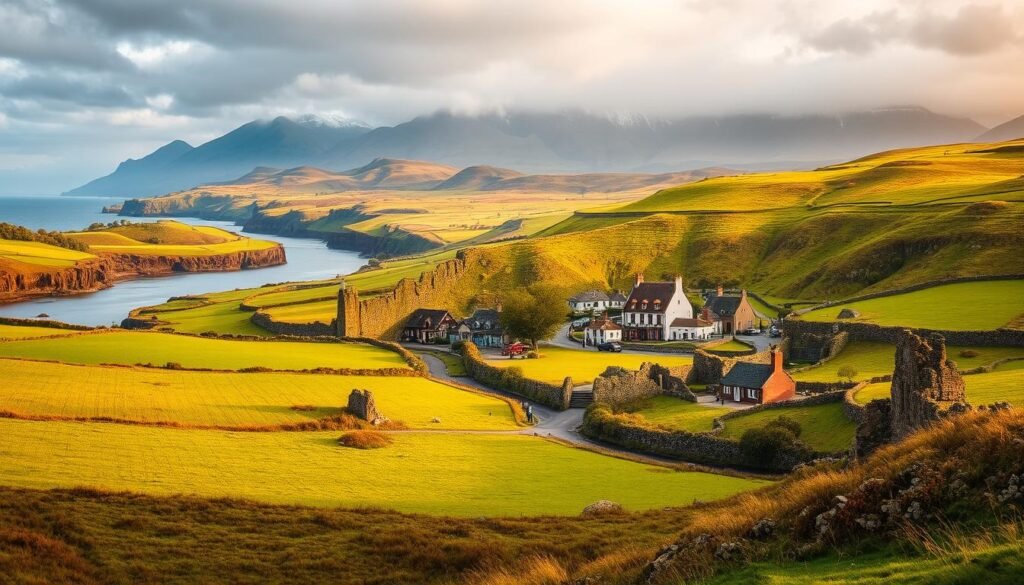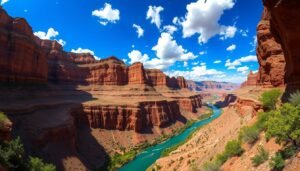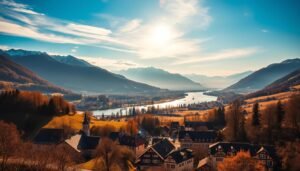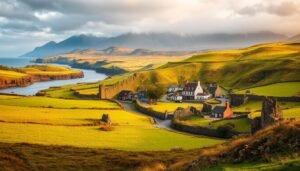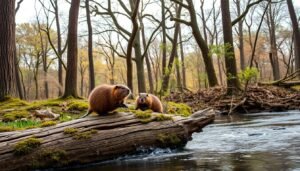Surprising fact: more than one in four visitors say the coastal drives were the highlight of their trip, a scale that reshaped how I planned mine.
I visited the country twice, in 2022 and 2025, routing the north counterclockwise first, then the south clockwise. That split helped me see the Wild Atlantic Way and its famous icons without rushing.
I previewed top spots like the Cliffs of Moher, Sliabh Liag, Giant’s Causeway, Dingle, and the Ring of Kerry. I also sought quieter places: Kinbane Castle, Crohy Head Sea Arch, and Silver Strand.
Practical note: Dublin framed both itineraries for me, with Trinity College, Temple Bar, and the Guinness Storehouse standing out. I share how much time I needed, where I joined tours, and when self-drive worked best.
What follows is a clear, regional list you can skim or read end-to-end, with pacing tips, parking notes, and the best viewpoints for photos and memories.
Key Takeaways
- A balanced north-south split helped me cover major places without rush.
- The Wild Atlantic Way links many top coastal views and drives.
- Dublin offers classic city stops that bookend longer trips.
- Family-friendly highlights included beaches, museums, and folk parks.
- I note where tours beat self-drive and where extra time paid off.
How I Planned My Ireland Trips: North vs. South, Time, and the Wild Atlantic Way

Splitting my travels into a rugged northern loop and a postcard‑perfect southern loop helped me test different paces and priorities.
Quick tips: book hotels early, rent a car for narrow country road stretches, and don’t skip the Wild Atlantic Way. That signed 2,500 km coastal way ties cliffs, beaches, and villages into a single, memorable route.
I found the 2022 north loop felt quieter and more adventurous, while the 2025 south loop delivered classic hits—Dingle, the Ring, Galway, and Dublin. For most visitors, the south is the iconic pick; the north gives solitude and rugged views.
- I’d split time roughly: 7 days for highlights, 10 days for a relaxed pace, 14 days for deep side trips and hikes.
- Group nearby stops into single days, book summer stays early, and plan a few rest evenings in small towns.
- Make sure you allow driving time versus sightseeing time so your trip feels enjoyable, not rushed.
Iconic things to do in ireland: Cliffs, castles, music, and coastal roads

I rearranged days around a few must-see spots—cliffs that took my breath, castles that begged for sunset, and nights alive with music.
Cliffs of Moher vs. Sliabh Liag: Cliffs of Moher rise to about 700 feet along 14 km and draw over a million visitors each year. Sliabh Liag climbs even higher and felt wilder, with far fewer people and huge Atlantic panoramas. For raw, sweeping views I favored Sliabh Liag at dawn; for easier access and classic photos I kept Moher on the main route.
Castles, abbeys, and memorable stops
Rock of Cashel is impressively preserved; book the Cormac’s Chapel add-on if you can. Dunluce castle perches on a sheer edge near the Antrim coast—I timed it for sunset light and stronger silhouettes.best-time-to-visit-glacier-national-park
Kylemore Abbey gave me calm reflections on the lake and a lovely Victorian Walled Garden walk. That half‑day felt like a small retreat from busy roads.
- I shared the photo angles I liked best and how I avoided peak crowds at cliff viewpoints.
- Quick planning: buy Rock of Cashel tickets ahead on busy days and aim for late afternoons at Dunluce.
- Live music nights in towns made places feel intimate—ask locals which pubs host sessions and wander in.
Practical note: I budgeted about 1–2 hours for castles and abbeys, 2–3 hours for the major cliffs, and left buffer time for coastal driving. Timing and route order made the difference between crowded snaps and quiet memories.
My Favorite Wild Atlantic Way Stops in the North and Northwest
![]()
The northern Wild Atlantic Way served up rugged geology, quiet beaches, and a string of stops I planned by light and tide.
Giant’s Causeway and Carrick‑a‑Rede: geology, legends, and walking paths
I walked the paved access road, took the shuttle from the visitor center, and chose the cliffside trail that led me down onto the hexagonal stones. The site has roughly 40,000 interlocking basalt columns; I lingered where waves pounded the pattern for the best views.
The Carrick‑a‑Rede crossing felt thrilling—nearly 100 feet above turquoise sea as you step toward a tiny island once used by salmon fishermen. Bring sturdy shoes and pair this crossing with nearby Dunluce or Kinbane for a full day.
Donegal gems: Glenveagh, Crohy Head, Silver Strand
Glenveagh blends lakes, a castle, and gardens with a loop I timed for late morning light. A short hike above the lake rewarded me with classic Donegal panoramas.things-to-do-in-long-beach-ca
Crohy Head Sea Arch and Silver Strand are quiet, photogenic spots I fit into a relaxed coastal afternoon. Pull over at small bayside parking and you can get great photos without long walks.
Cruit Island and Mourne Wall: light adventure with epic sea views
Cruit Island offered a mild guided climb and a zipline‑style rope swing that added a playful dash of adventure. The Mourne Wall approach is an easy path with big panoramas; expect a steady walk and 1–3 hours depending on your route.
- Quick tips: pack windproof layers, watch your step on edges, and pace the road stops so you can enjoy the light. I highly recommend visiting at dawn or late day for softer light and fewer crowds.
Galway, Connemara, and the Burren: Nature, history, and a scenic Greenway
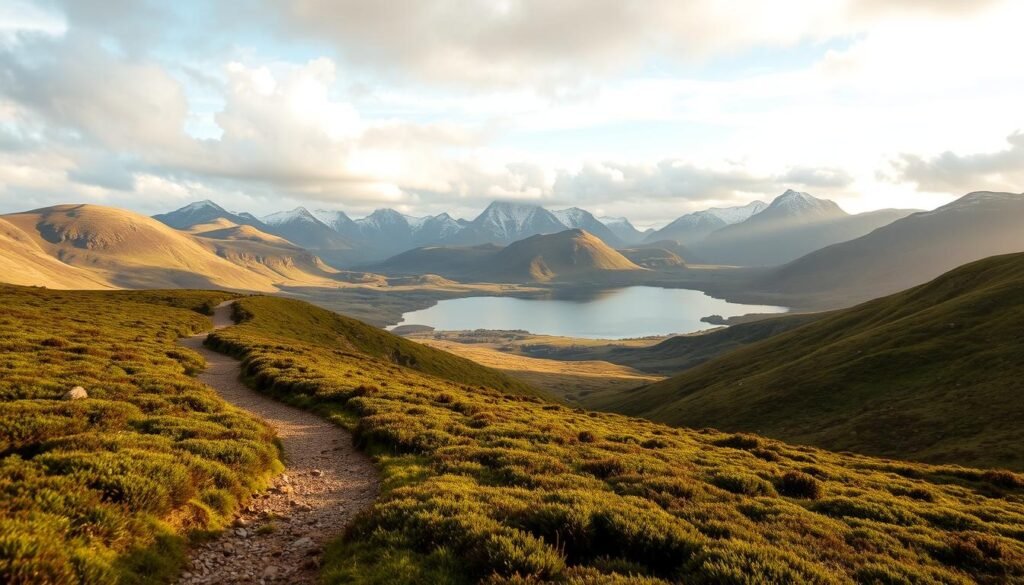
I split my time between a lively city base in Galway and wide landscapes that favored walking and photos.things-to-do-in-budapest
Diamond Hill climbs about 1,300 feet over two miles and gave me commanding views of fjords and sea. I paced the ascent, turned around at the upper ridge when short on time, and kept stopping for the ridgeline light.
Fairytale stops and ancient stones
Kylemore Abbey pairs a lakeside mansion with a Victorian Walled Garden and a pretty neo‑gothic church. The shuttle to the gardens made lingering easy; I split my visit between the church, garden, and lakeshore reflections.best-time-to-visit-new-orleans
The Burren’s limestone pavement hosts Poulnabrone Dolmen and guided walks that unlock geology and culture. That odd stone landscape sits near cliffs moher and rewards a slow, curious pace.
| Spot | Main draw | Time |
|---|---|---|
| Diamond Hill | Views, hike | 2–3 hrs |
| Kylemore | Abbey & garden | 1.5–2 hrs |
| Greenway | Flat cycling | Half day |
Great Western Greenway offered a mostly flat ride, sheep‑lined views, and rental shops. I recommend picking one hike, one abbey stop, and one easy cycle day when time is tight.
Killarney National Park: Waterfalls, lakes, and views I highly recommend

I planned one light but full day around Killarney’s highlights, timing walks and a boat ride so the light worked for photos and the pace stayed relaxed.
Torc Waterfall and Muckross House: easy walking, dreamy photos
Torc Waterfall is an 8‑minute walk from a small lot, which made it perfect for a quick sunrise or late‑day long exposure.
Muckross House grounds were free to roam, so I looped the estate paths and saved the ticketed house visit if I had extra time.
Ross Castle, Jaunting Car, and a serene boat tour on Lough Leane
Ross Castle sits right on the lake; I took a jaunting car through the woods then an hour boat tour to Innisfallen Island.best-time-to-visit-fiji/
The combo covers forest, castle, and lake without rush and felt like one of the best parts of my southern loop.
Ladies’ View and the Gap of Dunloe: road, walking, and tour options
Ladies’ View gives sweeping panoramas—I added a short walk for a cleaner line toward the ridges.
“If you only have one day, base yourself in Killarney town and layer easy walks with a single scenic ride.”
- I parked at Kate Kearney’s Cottage for Gap of Dunloe access and chose walking when I wanted quiet, or a horse-and-buggy tour when I wanted a story-led pace.
- Small parking lots and ticket choices at Ross Castle mean tours often save time and effort.
Pacing blueprint: Torc at golden hour, a gentle Muckross loop mid-morning, lunch in town, then Ross Castle plus boat. Finish at Ladies’ View or the Gap if time allows.
Ring of Kerry and Dingle Peninsula: Coastal drives, sea safaris, and small towns

A coastal loop from Killarney toward the Dingle Peninsula delivers classic Atlantic panoramas and tiny harbors worth slowing for. The Ring Kerry circuit is famous for good reason, but pairing it with Slea Head adds quieter bays and stone‑ringed viewpoints.best-cities-to-visit-in-japan/
Slea Head Drive has a string of easy pullouts where I parked, stepped out, and shot without large crowds. I sequenced stops so parking was simple and compositions stayed clean—beach first, then headlands, then historic sites.
Slea Head pullouts and photo stops
I list my favorite pullouts: a small beach with an island view, a stone fort, and a cliffside bend that frames sunset reflections. Make sure you pause at marked bays rather than attempting photos from narrow shoulders.best-time-to-visit-chicago/
Dingle Sea Safari and harbor time
I booked a tour on the Dingle Sea Safari to add caves, cliffs, and wildlife to an otherwise land‑based day. The boat shows puffins and dramatic sea caves best at calm water; reserve space in peak season.
- I split time by overnighting in Dingle so music, dinner, and a harbor walk didn’t feel rushed.
- Compare Ring Kerry vs. Dingle: Ring is broader coastal variety; Dingle feels intimate and marine‑rich. If you have two days, do both.
- Favorite pauses: a coastal café for coffee, a bakery near the harbor, and one island‑facing viewpoint for sunrise or sunset.
“An overnight in Dingle turned a long driving day into a relaxed coastal retreat.”
Dublin My Way: Trinity College to live music and the perfect pint
![]()
Dublin’s center is wonderfully walkable, so I built a short route that covers classic stops without rushing. I started at Trinity College, wandered through cobbled lanes, then slipped into Temple Bar and St. Stephen’s Green for a leafy pause.things-to-do-in-gainesville-fl
Top city hits: Trinity College, Temple Bar, Dublin Castle, St. Stephen’s Green
I timed visits to match light and crowds. The college quad is best early, museums open mid-morning, and the castle grounds feel quieter late afternoon.
Guinness Storehouse views and a Riverdance night I won’t forget
The Guinness Storehouse spans seven floors and finishes with a 360‑degree Gravity Bar view. I budgeted roughly 2 hours and joined a guided tour once to skip lines and learn the brewing history.
- Pubs and music: family-friendly early evenings, live music later—I listened from a bench when I wanted a calm night.
- Riverdance: high energy, live band, runs ~2 hours; great for ages 10+ and worth planning around show hours.
- Mini plans: half-day—Trinity, a museum, quick coffee; full day—add Guinness, dinner, an evening show.
“A short walking loop tied arrivals and departures together and left time for one great pint.”
For practical links and a detailed Trinity visit guide, see Trinity College visitor info.
Wicklow Mountains Day from Dublin: Spinc Trail, Sally Gap, and Lough Tay

A single day south of Dublin sent me into the Wicklow highlands for a brisk loop hike and a scenic drive that rewarded small stops and big views.best-time-to-visit-colorado/
I started early with the Spinc Trail above Glendalough’s Upper Lake. The Round Tower and St. Kevin’s Church sit close by, so I mixed a short history stop with the walk.
If I had extra hours I’d linger at the ridge for softer light and add a longer loop around the lake for varied compositions.
Driving narrow roads: photo pullouts at Glenmacnass and Lough Tay
After the hike I drove a narrow mountain road toward Glenmacnass. There’s a small pullout just before the falls — that point gave me the best angle for photos without scrambling.
Sally Gap is a simple junction on the plateau; the signed Lough Tay viewpoint has a short walk that lifts your framing from good to great.
- I booked a rental car early but kept a cushion for pickup time and possible delays.
- If you’re uneasy on tight country lanes, a guided tour is worth considering — it saves time and stress.
- Pack snacks, use the park facilities before the loop, and aim to leave before Dublin’s evening traffic.
Wicklow Mountains National Park has maps and practical tips if you want official guidance.
Northern Ireland Road Notes: Dunluce at sunset, Kinbane solitude, and Titanic Belfast
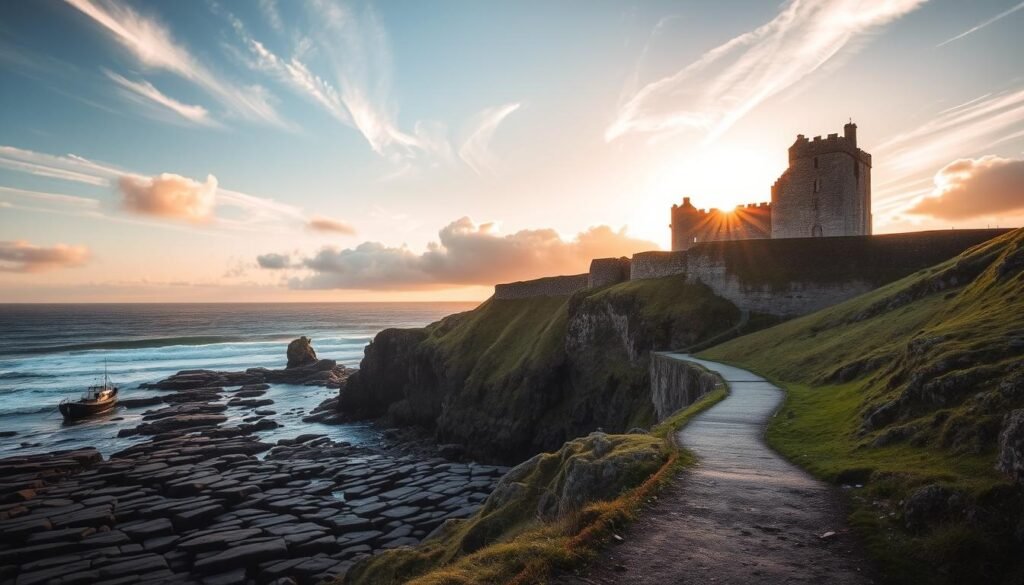
Driving the north, I treated golden hour as a scheduling anchor—especially near cliffside ruins and sea stacks.
Dunluce castle perches on a sheer cliff. I timed my arrival an hour before sunset so the warm light carved texture from the stone and cliffline. That extra time made photos and the walk feel calm instead of rushed.
Kinbane sits on white limestone and gave me surprising solitude. I fit it between Giant’s Causeway and Carrick‑a‑Rede on a short coastal run, which kept me moving without backtracking along the main road.best-time-to-visit-norway
Downpatrick Head, Titanic Belfast, and Derry
Downpatrick Head stunned with the Dun Briste sea stack and blowholes; check wind forecasts and stay well back on slick rocks.
Titanic Belfast is a large interactive museum—I set aside about two hours and checked cruise timetables to avoid peak crowds of visitors. Booking ahead saved time at the entrance.
In Derry city I joined a guided tour of the walls and Bogside murals. The personal stories made local history vivid and left space for reflection rather than a quick checklist.
- Road note: link stops clockwise to limit zigzags; use small harbors for lunch breaks.
- Best spots to linger: Dunluce western wall at sunset, the Kinbane headland, and a quiet bench by the Peace Bridge.
“Booking a guided walk in Derry added depth—some routes reveal stories you won’t find on your own.”
I would repeat a sunset at Dunluce and a Derry walk next trip. If weather turns, swap Kinbane for an extra museum hour in Belfast or extend a city lunch for a slower afternoon.
For a coastal route that ties these stops together, see the Causeway coastal route.
Family‑Friendly Moments I Loved: beaches, abbeys, museums, and walks
I found that mixing short hikes with calm beaches kept every day lively but manageable. Small stops offered variety and the kids stayed curious without getting worn out.
Coastal gems and easy walks. Rossnowlagh Beach paired neatly with the Sandhouse Hotel and a local surf school for beginner lessons. That made a low‑stress beach day feel like a real seaside mini‑break.
Assaranca Waterfall was a quick roadside pull‑in that surprised us after rain. Achill Sound worked as the perfect base for exploring Achill Island without complex logistics.
Short nature stops and gentle walks
The Fairy Bridges near Bundoran sit beside the Rougey Cliff Walk. It’s an easy stroll that both kids and grandparents enjoyed.
Immersive history and modern galleries
The Ulster American Folk Park is a living history museum with hands‑on sets that make emigration feel personal. Dublin’s EPIC museum uses interactive galleries that hit home for many people in our group.
- I paced family days by alternating play with short attractions and kept snack breaks handy for the car.
- Plan an early dinner in a friendly town and maybe a little music afterward to end on a high note.
- Tip: check opening hours before you go so a museum or site visit fits the rhythm of the day.
“Simple stops, short drives, and a mix of action and calm turned long travel days into shared discoveries.”
Practical Tips: Tours, driving, best photo times, and how to pace your days
A few simple timing choices turned crowded mornings into quiet photo hours and relaxed afternoons. Expect quick weather shifts along the coast and plan around light as much as distance.
When to go, handling weather, and timing for crowd‑free photos
For milder weather and fewer visitors, I aimed for shoulder months and weekdays where possible. Early morning and late afternoon gave me the best photos and smaller crowds at Torc Waterfall, the Cliffs of Moher, and Slea Head.things-to-do-in-portland/
Rain forced swaps: I moved indoor museums into wet hours and kept cliff visits for clearer windows. That simple flip saved a lot of time and frustration.
Tour picks vs. self‑drive: when I book a guide and why
I booked a tour for boat trips, Carrick‑a‑Rede slots, and Titanic Belfast to skip lines and gain local context. Self‑drive won when I wanted freedom for detours and slow viewpoint stops along narrow road stretches.
Rental notes: allow buffer at the counter, check insurance options, and keep snacks and layers in the car. My morning checklist always read: fuel, tickets, layers, and updated opening times—make sure those are set before you leave.
- Simple daily rule: one major stop + one or two short viewpoints = a relaxed day with great views.
- Timing framework: drive window + experience window + buffer prevented bad surprises.
- Quick essentials: lens cloth, rain layer, snacks, and a small first‑aid kit kept photo plans intact.
“I found that treating each drive as a sequence of short windows let me enjoy more views and less rush.”
For a compact routing idea and timing examples, see this one-week itinerary I used as a base on busier stretches of my trip.
Conclusion
Conclusion
My rule became simple: one major stop per day, an open window for weather, and room to linger. That balance let me enjoy coastal drives, quiet national park trails, and lively town nights without rush.
I split the trip by parts—north for solitude, south for classic views—and the Wild Atlantic Way tied those days together. Two highlights I revisited were cliffs moher viewpoints and a calm Killarney National Park morning; both felt like one best memories from different years.
Book a tour where lines matter, drive where flexibility helps, and save an extra night in a music-filled town. Pick a few stone, castle, or museum stops and breathe—this way your trip becomes about people, place, and the views that stick.things-to-do-in-atlantic-city


